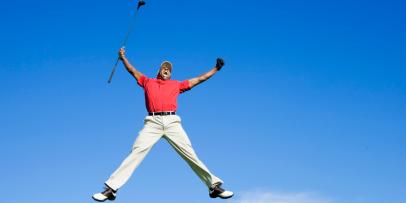Create that side bend
This is a big difference between good and bad golf swings—here's how to spot it

Ben Jared
For generations, practically as long as golfers have been hitting golf balls, they've struggled with slices. It's a sad but unfortunate fact. If you're a higher handicap struggling with a pesky miss, it's probably one that moves from left-to-right.
There are lots of reasons why, but one of the biggest reasons is because golfers tend to screw up their golf swing's sequence—which, put simply, is the order in which different parts of your body fire during your swing.
Pros generally shift their weight toward the target during their transition and begin rotating around their lead leg, but many amateur golfers start their downswing not with a shift, but simply by turning too soon. With their weight still on their trail leg, turning too soon with their upper body drags the club over the top, and when paired with an open clubface, carves the ball out to the right.

It's a common fault, so common in fact that it's a move Golf Digest's own Sam Weinman makes in his swing. You can see his club coming over the top below (and can watch this awesome video of Sam playing golf with Joel Dahmen right here).
How to spot—and stop—chest sway
As for how you can spot this is happening: Look at how the upper and lower bodies are moving in relationship to each other. In the video here from SportsBox AI, an app which uses artificial intelligence to track different movements in your golf swing in 3-D, you can see the difference between "the best" and "the rest" shows up in the "chest sway" metric.
Tour players tend to have a lot less chest sway at impact than the rest of us. That means pros' upper bodies are tilted away from the target more at impact. Amateur golfers, by contrast, have their chest and lower body in more of a straight line.

As Golf Digest Best in State teacher Kelan McDonah, the Director of Instruction at Metedeconk National Golf Club, shows us in recent winner's Max Homa's swing using the same app (below), pros do this because they keep they shift their lower body towards the target while keeping their upper body in the same place. Homa's swing provides an example: His pelvis moves four inches closer to the target than where it started, while his chest remains in the same spot.
That's the magic move that creates side bend. Shifting your lower body toward the target on the downswing while keeping your torso back. It'll be a lot harder to slice the ball from that position.
